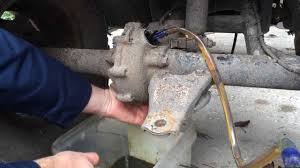
What is a Differential and Do I Have to Change the Oil in It?
Share
Understanding the Differential
When it comes to the inner workings of your powersports vehicle, the differential is a crucial component that often goes unnoticed. The differential is responsible for transferring power from the engine to the wheels, allowing them to turn at different speeds. It plays a vital role in ensuring smooth and controlled turns while driving.
Types of Differentials
There are several types of differentials commonly found in vehicles, including open differentials, limited-slip differentials, and locking differentials. Each type has its own unique characteristics and performance benefits.
- Open Differentials: This is the most common type of differential. It allows the wheels to rotate at different speeds, providing better traction and stability during turns. However, it may not be suitable for off-road or high-performance applications.
- Limited-Slip Differentials: These differentials use a system of clutches or viscous fluids to distribute torque between the wheels. They offer improved traction and handling, making them great for both on-road and off-road driving.
- Locking Differentials: Locking differentials provide maximum torque to both wheels simultaneously, ensuring equal power distribution. They are commonly used in off-road vehicles to overcome challenging terrains.
The Importance of Differential Oil
Just like the engine or transmission, the differential requires proper lubrication to function smoothly. Differential oil, also known as gear oil, is specifically designed to withstand the high pressures and temperatures generated by the gears inside the differential.
Differential oil serves multiple purposes:
- Reducing friction: The gears inside the differential rotate at high speeds and generate friction, which can lead to wear and tear. Differential oil forms a protective layer between the gears, reducing friction and preventing damage.
- Cooling: The differential can get hot during operation due to the friction and heat generated. Differential oil helps dissipate heat, preventing overheating and ensuring optimal performance.
- Cleaning: Over time, debris, metal particles, and contaminants can accumulate in the differential. The oil acts as a cleaning agent, carrying away these particles and keeping the differential clean.
When to Change Differential Oil
Regular maintenance of your differential is crucial to prolong its lifespan and ensure optimal performance. The manufacturer's recommended maintenance schedule typically outlines when to change the differential oil, but it is generally advised to have it changed every 30,000 to 50,000 miles.
However, certain driving conditions may require more frequent oil changes. If you frequently tow heavy loads, drive in extreme temperatures, or engage in off-road adventures, it is recommended to change the differential oil more frequently.
Additionally, if you notice any signs of trouble such as unusual noises, leaks, or difficulty in turning, it is advisable to have the differential oil checked and changed if necessary, regardless of the mileage.
The Benefits of Changing Differential Oil
Changing the differential oil at regular intervals offers several benefits:
- Improved lubrication: Fresh oil provides better lubrication, reducing friction and wear on the gears. This leads to smoother operation and enhanced overall performance.
- Enhanced efficiency: As the gears move more freely with clean and properly lubricated oil, the differential operates more efficiently, resulting in improved fuel economy.
- Extended lifespan: Regular oil changes prevent premature wear and damage, ensuring the longevity of the differential. This helps you avoid costly repairs or replacement in the future.
- Reduced heat buildup: Clean oil with the right viscosity helps dissipate heat effectively, preventing overheating and potential damage to the differential.
How to Change Differential Oil
Changing the differential oil can be done by following these steps:
- Consult your vehicle's owner manual for specific instructions and the type of oil recommended for your differential.
- Prepare the necessary tools, including a wrench, a drain pan, and a funnel.
- Locate the differential drain plug, usually located on the bottom of the differential housing.
- Place the drain pan underneath the drain plug, then use the wrench to loosen and remove the plug, allowing the old oil to drain completely.
- Once the oil has drained, clean the drain plug and the surrounding area.
- Replace the drain plug and tighten it securely.
- Locate the differential fill plug, usually located on the side of the differential housing.
- Using the funnel, pour the recommended amount of fresh differential oil into the fill hole.
- Replace the fill plug and tighten it securely.
- Wipe off any excess oil and ensure there are no leaks.
It is important to note that the process may vary depending on your vehicle's make and model, so it is always recommended to consult your owner manual or seek professional assistance if you are unsure.
Consult a Professional
While changing the differential oil is a relatively simple task, it is always recommended to consult your vehicle's owner manual or seek professional assistance. They can provide specific guidance based on your vehicle's make, model, and driving conditions.
Additionally, a professional mechanic will ensure the correct type and quantity of oil is used, and they can inspect the differential for any potential issues during the oil change process.
By understanding the importance of the differential and the need for regular oil changes, you can ensure that your vehicle performs optimally and remains reliable for years to come.
